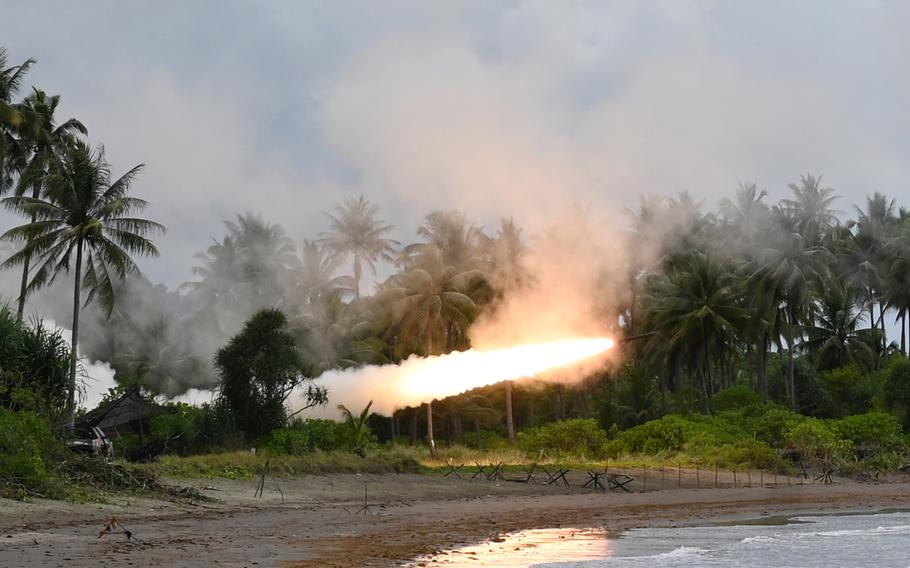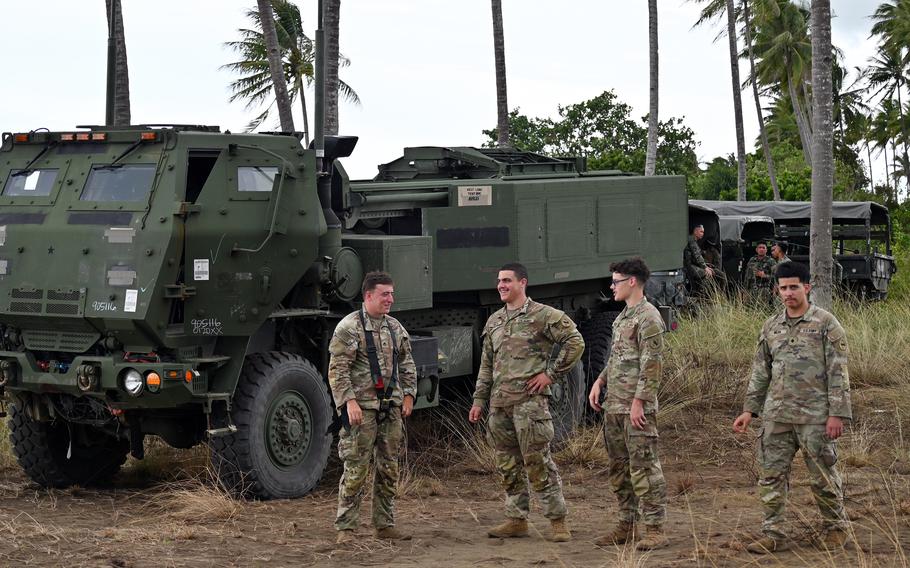
U.S. soldiers with the 5th Battalion, 3rd Field Artillery Regiment fire a High Mobility Artillery Rocket System, or HIMARS, from the west coast of Palawan, Philippines, April 28, 2025. (Seth Robson/Stars and Stripes)
PALAWAN, Philippines — The U.S. Army task force that brought six High Mobility Artillery Rocket Systems to the recently concluded Balikatan exercise has maintained a presence in the Philippines since 2022, according to one of its battalion commanders.
The 1st Multi-Domain Task Force’s 5th Battalion, 3rd Field Artillery Regiment fired six rockets into the South China Sea from a HIMARS launcher positioned April 28 near Palawan’s western coast. The island province lies lengthwise against the sea, where the Chinese and Philippine coast guards sometimes clash over maritime claims.
The task force, based at Joint Base Lewis-McChord, Wash., has maintained a regular presence in the Philippines over the past few years, battalion commander Lt. Col. Ben Blane said in a phone interview Sunday. Last year marked the battalion’s first exercise on Palawan.
Troops from the battalion now commonly spend two to three rotations of 30 to 60 days each year in the islands, Blane said.
“When we are out here it is like a rotational force now,” he said.

U.S. soldiers with the 5th Battalion, 3rd Field Artillery Regiment navigated winding roads and mud tracks to get a High Mobility Artillery Rocket System, or HIMARS, to the west coast of Palawan, Philippines, for live-fire training on April 28, 2025. (Seth Robson/Stars and Stripes)
The HIMARS, typically used to strike ground targets, demonstrated its anti-ship potential during Balikatan, the annual U.S.-Philippine military exercise.
This year’s drills, which concluded Friday after 18 days, involved approximately 9,000 U.S. and 5,000 Philippine troops. They were joined by 260 Australians and smaller contingents from Japan, the United Kingdom, France, Canada and others for island-defense training.
Blane said the HIMARS battalion trains in spots where it might be called upon to support Philippine forces in a real-world scenario. The system is capable of firing from austere environments.
Balikatan provided troops with practical experience in moving HIMARS batteries across the archipelago, involving air, land and sea transport.
“Getting from A to B can be a challenge in the Philippines,” Sgt. 1st Class Shaun Moore, a master gunner, said by phone Sunday.
The unit maneuvered through a congested port, winding roads and muddy terrain to move their launchers to the training area on Palawan.
The HIMARS traveled aboard commercial and military vessels, line-haul trucks and C-130 aircraft, Blane said. Upon arriving in Bataraza, in southeast Palawan, troops formed a convoy that cautiously navigated low-hanging power lines en route to the coastal training site, Moore said.
For the final mile, soldiers moved their HIMARS along swampy tracks to the firing point, where they camped alongside U.S. Marines and Australian troops, said Blane and Moore.
“The firing point was unimproved,” Blane said. “We don’t need a Gucci level of service.”